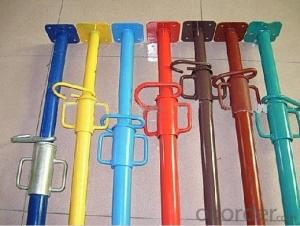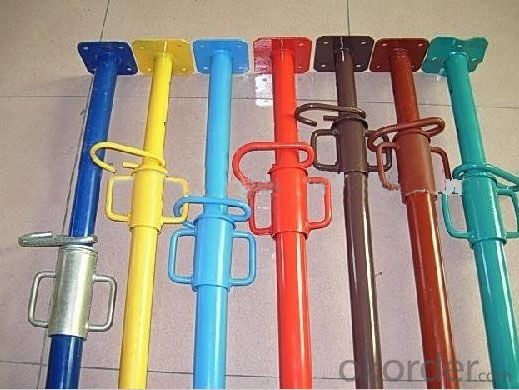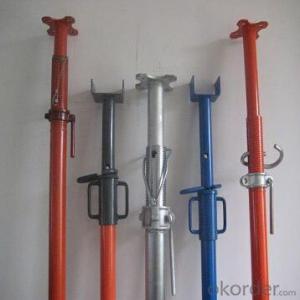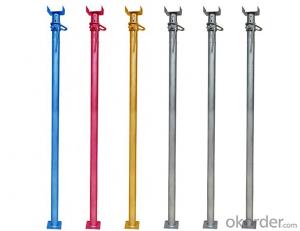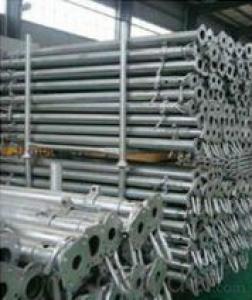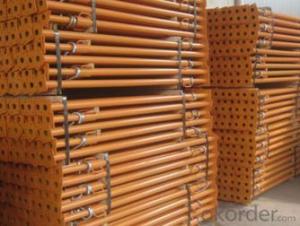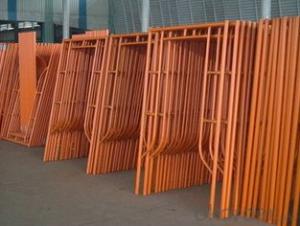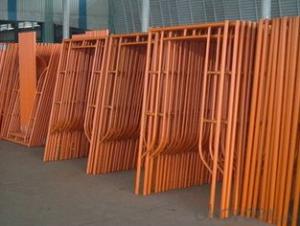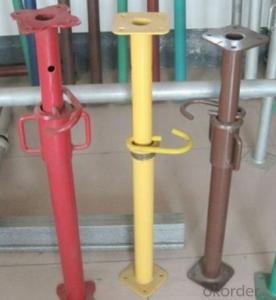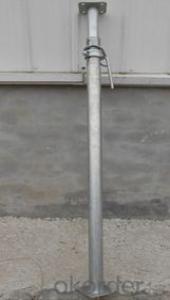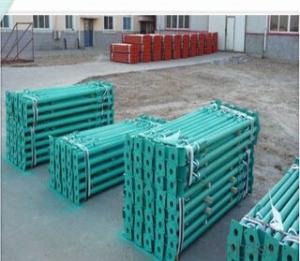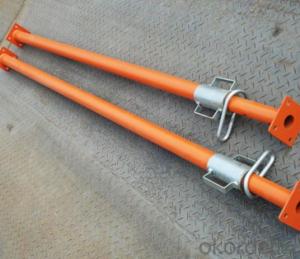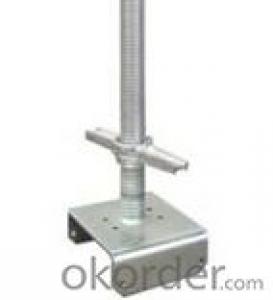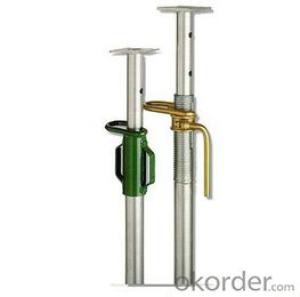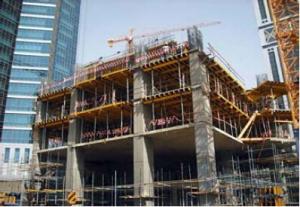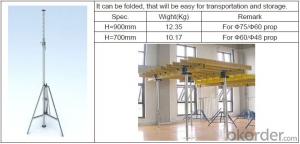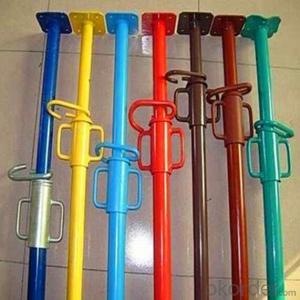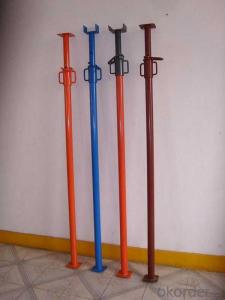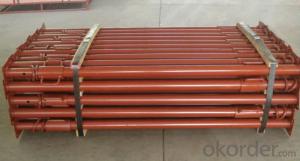construction u head adjustable steel painted scaffolding prop
- Loading Port:
- Tianjin
- Payment Terms:
- TT OR LC
- Min Order Qty:
- 10 m.t.
- Supply Capability:
- 10000 m.t./month
OKorder Service Pledge
OKorder Financial Service
You Might Also Like
construction u head adjustable steel painted scaffolding prop
Types of Shoring Props
We produce different kinds of steel props, post shore, shoring props, slab props, floor props, U head props for all range floor formwork and slab formworks, covering nearly all light and heavy construction requirements, surface treatment can be painting, powder coating, electro galvanized, and hot dip galvanized.
We also produce high quality European slab props according to EN1065 standard, durable, hot dip galvanised treated, made from high quality solid steel, safety catch design and cost efficient.






Packing



Our Company

Introduction
CNBM Metal International Corporation was found in 1984. It is a professional manufacturer of
casting parts for industrial, formwork and scaffolding field. There are altogether 300
employees including 43 technicians and 10 senior engineers. The weight of each casting part
ranges from 0.1kg to 10 tons. The products are extensively used on construction machinery,
building equipment, formwork and scaffolding. The products are mainly exported to foreign
countries like Europe, America, Great Britain, Canada, Japan, Middle East, etc.
Enterprise Development
1, To decide the product structure according to the market equipment
Basic strategy: To develop casting and punching part steadily for industrial, formwork and
scaffolding and actively expand market in all over the world, and improve the manufacturing
level.
2, continuously improvement is our tenet and customer’s satisfaction is our goal.
Continuously improvement is the method for persistent progress, focusing on details is the
way of process control, and exceeding the customer’s expectation is our eternal pursuit.
3, Continuous development
To develop, enlarge and strengthen is the basis of enhancing market competitiveness and
basic on human oriented to strength teamwork, improve management level, insist on steady
and continuous development is the tenet of achieving the “ A century company”.



Quality Inspection
In regard to meet the quality requirement, our testing lab is established with different kind of
material inspection equipment, the inspectors are trained with professional inspecting
knowledge and working experience at site. The testing report for each shipment is properly
recorded and convenient for customer and our chief engineer to check out and track
according specified shipment.

tag: steel prop nut
- Q: Big steel pipe support painted what color look good
- This color has a hint of warmth, like polished bronze, polished.
- Q: Are steel props suitable for use in confined spaces?
- In confined spaces, steel props are generally unsuitable due to limited ventilation, restricted access, and potential presence of hazardous gases or substances. Maneuvering heavy steel props in tight spaces can be dangerous. Moreover, the size and weight limitations of steel props may result in insufficient support. Therefore, it is crucial to opt for props specifically designed for confined spaces. Adjustable aluminum or hydraulic props are lightweight, portable, and meet the safety requirements of these environments.
- Q: Can steel props be used in supporting precast concrete elements during installation?
- Steel props, also referred to as adjustable steel props or adjustable steel shores, can be utilized to provide support to precast concrete elements while they are being installed. In the realm of construction, steel props are commonly employed as a temporary support system for structures or elements. They are specifically beneficial in the context of precast concrete elements due to their durability, ability to be adjusted, and stability. When installing precast concrete elements, steel props are typically positioned beneath the elements to offer vertical support and prevent any sagging or collapse. The height of the props can be easily modified to accommodate different elevations or to ensure a level installation. This adjustability is particularly advantageous when dealing with uneven ground conditions or when aligning multiple precast elements. Steel props are engineered to endure substantial loads and provide a dependable support system for precast concrete elements. They are typically fabricated using high-quality steel with a robust construction, enabling them to bear the weight of the elements without any deformation or failure. In addition to their strength and adjustability, steel props provide stability throughout the installation process. They are equipped with base plates or feet that establish a solid foundation, ensuring that the props remain securely in place. This stability is crucial in preventing any unforeseen movement or shifting of the precast elements, which could potentially result in damage or safety hazards. All in all, steel props are a suitable choice for supporting precast concrete elements during installation. Their strength, adjustability, and stability make them a reliable and efficient solution for ensuring a successful and safe installation process.
- Q: Are steel props adjustable in small increments or only in larger steps?
- Steel props are adjustable in small increments, allowing for precise adjustments to suit specific requirements.
- Q: What are the typical applications for steel props?
- Steel props, also known as adjustable steel props or steel shore props, are commonly used in construction and building projects for various applications. They are primarily used for providing temporary support and stability to structures during construction or renovation. Some typical applications for steel props include: 1. Formwork Support: Steel props are extensively used to support formwork systems during concrete pouring. They help in maintaining the structural integrity of the formwork and prevent it from collapsing under the weight of the concrete. 2. Slab and Beam Support: Steel props are used to provide temporary support to slabs and beams during construction. They help in distributing the load evenly and prevent sagging or bending of the structure. 3. Shoring and Scaffolding: Steel props are commonly used in shoring and scaffolding systems to provide support and stability to temporary structures. They ensure the safety of workers and materials by preventing collapse or deformation of the structure. 4. Excavation Support: Steel props are used to support excavations or trenches during construction projects. They help in preventing soil collapse and ensure the stability of the surrounding structures. 5. Temporary Support during Demolition: Steel props are employed to provide temporary support to structures during demolition or renovation. They help in preventing accidental collapses and ensure the safety of workers and nearby structures. 6. Temporary Support for Structural Repairs: Steel props are used to provide temporary support to damaged or weakened structures during repair or reinforcement. They help in maintaining the stability of the structure until permanent repairs can be made. In summary, steel props are versatile tools used in construction projects for various applications such as formwork support, slab and beam support, shoring and scaffolding, excavation support, temporary support during demolition, and temporary support for structural repairs. They play a critical role in ensuring the safety and stability of structures during construction, renovation, and repair processes.
- Q: Are steel props suitable for supporting temporary communication infrastructure?
- Yes, steel props are suitable for supporting temporary communication infrastructure. Steel props are strong and durable, making them capable of providing stable support for various types of equipment and infrastructure, including communication systems. Additionally, steel props can be easily adjusted and customized to different heights and load requirements, making them versatile for temporary installations.
- Q: Are steel props suitable for supporting temporary canopies or awnings?
- Yes, steel props are suitable for supporting temporary canopies or awnings. Steel props, also known as adjustable steel props or steel shores, are used to provide temporary support in construction projects. They are specifically designed to bear heavy loads and can be easily adjusted to the desired height. Steel props are strong, durable, and stable, making them ideal for supporting temporary canopies or awnings. They can withstand various weather conditions and provide a secure base for the structure. Additionally, steel props can be easily assembled and disassembled, allowing for quick and efficient installation of canopies or awnings. Overall, steel props are a reliable and practical choice for supporting temporary canopies or awnings.
- Q: Are steel props suitable for both indoor and outdoor applications?
- Yes, steel props are suitable for both indoor and outdoor applications. Steel props, also known as adjustable steel props or steel shoring props, are versatile support systems used in construction and renovation projects to provide temporary support to ceilings, walls, and other structures. The durability and strength of steel make it a suitable material for outdoor applications, as it can withstand harsh weather conditions such as rain, wind, and extreme temperatures. Steel props are often galvanized or coated to protect against corrosion, further enhancing their suitability for outdoor use. Indoor applications also benefit from the use of steel props. They are commonly used in residential and commercial projects to support ceilings during repair or installation, provide temporary support during construction work, or to reinforce weak or damaged walls. Steel props are adjustable in height, allowing for flexibility and adaptability in various indoor and outdoor scenarios. They can be easily extended or retracted to fit different ceiling or wall heights, making them suitable for a wide range of projects. In summary, steel props are a reliable and versatile solution for both indoor and outdoor applications. Their strength, durability, and adjustability make them suitable for supporting structures in various construction and renovation projects, regardless of the location or environmental conditions.
- Q: Are steel props resistant to chemical exposure?
- Chemical exposure is usually not a problem for steel props. Steel possesses remarkable durability and strength, which enables it to withstand a wide range of chemical substances. Nevertheless, the level of resistance can vary depending on the particular chemical type and concentration that the steel props are exposed to. Occasionally, specific corrosive chemicals or acids can gradually deteriorate and corrode the steel. Thus, it is crucial to take into account the precise chemical surroundings and seek advice from experts to select the most appropriate materials for the intended application, ensuring long-lasting durability and safety.
- Q: Subway construction of steel support needs qualification
- Qualification required.The subway is referred to as the "underground railroad", city rail transit system in narrow sense refers to operation of the underground.
Send your message to us
construction u head adjustable steel painted scaffolding prop
- Loading Port:
- Tianjin
- Payment Terms:
- TT OR LC
- Min Order Qty:
- 10 m.t.
- Supply Capability:
- 10000 m.t./month
OKorder Service Pledge
OKorder Financial Service
Similar products
Hot products
Hot Searches
Related keywords
